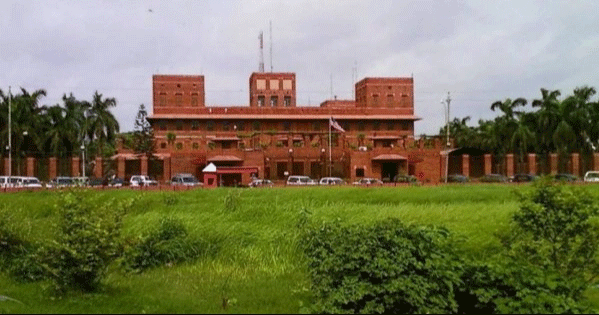Bangladesh targets $110b export earnings by 2027
Mahfuz Emran : Bangladesh has set up an export earning target of $110 billion by the year 2027. But the experts said that it would be an unrealistic and high ambitious decision.
On November 24, 2026, Bangladesh will be promoted from least developed to developing country, subject to the recommendation of the United Nations General Assembly. As a result, the tariff and quota-free benefits currently available in the markets of developed and developing countries will no longer match. Bangladeshi exporters will have to export products to the European Union (EU) market with an average of 10 percent duty. In such a context, the government has set a target of $110 billion export income in the new policy for the period of 2024-27. Although it is considered almost impossible to achieve it, the people involved in the export sector think.
Export Policy 2021-24 expires in June this year. Therefore, the Ministry of Commerce has formulated a three-year draft of 2024-27 through multiple discussions with the sector-wise stakeholders. The draft of the new policy has also been published on the ministry’s website for final opinion. Opinions will be taken on it till March 2.
The preamble to the export policy states that the government has been pursuing an export-oriented growth strategy with the aim of promoting Bangladesh to a developed, prosperous and high-income country. Achieving all the criteria of transition from a less developed country has created a positive image of Bangladesh in the world and created new possibilities for investment and trade. However, this transition will create several challenges in the country’s export sector at the time set by the United Nations. One of these is the loss or limitation of tariff and quota-free market privileges in international markets under the
World Trade Organization (WTO). In order to meet this challenge, production of quality products and services at more competitive prices, diversification of export products and markets, investment attraction is essential.
Export sector stakeholders say that in the current global and domestic context, the export policy revenue target is almost impossible to achieve by 2027. However, they claim, if well-thought-out and strategic government support is ensured, it may be possible to reach the target. Besides, they also say that the revenue target set in the government’s export policy has never materialized so far. This time the goal will be more challenging. Because it is difficult to determine when the current global economic instability will end.
Exporters Association of Bangladesh (EAB) Senior Vice President Mohammad Hatim told, “In the current global context, it is almost impossible to achieve the target of income in the export policy. Now the crisis is everywhere. In the global context, the demand has come down a lot. Energy crisis within the country. Gas supply is not uninterrupted even at higher prices. Bank loan interest rate has also increased. Again, the export facility is being withdrawn in the context of LDC graduation. All in all, achieving the goal is almost impossible.
Trade analysts say that the export policy’s revenue targets are often not aligned with reality. From the policy-making stage in informal conversations, it’s not a bad thing to be a little over the top when setting goals! But the reality is that if the goals are not consistent with the reality, then there is a chance that the actions taken in the light of the policy will not be appropriate. Moreover, various questions remain about the statistics of the country’s export income. What is being said on the part of the government, it can be seen that in reality the receipt of money is very less against the export. All in all, policy formulation should be based on reality.
Policy Research Institute (PRI) executive director Ahsan H. Mansoor told, “In determining the target of export income, both goods and services have been taken into consideration. That’s why the goal seems big. Policy formulation should match reality. It is also important to look at how much growth has occurred historically. Our performance in exports is not good. Exports could not be increased to the desired extent in the past. The pace of growth is not the same as before. New products could not be released. Apparel exports may increase, but not enough. And the export of non-clothing products is far from increasing, on the contrary, it is decreasing. Exports are not diversifying, foreign capital is not coming, it has stopped. As a result, there is no possibility of a sudden increase in exports. These are the facts. If the condition or environment is good, the growth may be 10-12 percent.
The export policy is formulated for a period of three years. According to the Ministry of Commerce, the target of export earnings for the period 2015-18 is set at $60 billion. The revenue target was also unchanged in the policy for the period 2018-21. The ongoing policy for the period 2021-24 was formulated with an export target of $80 billion by 2024. And in the draft of the policy for the new term, a target of export earnings of $110 billion has been set. Although the Ministry of Commerce itself thinks that if Bangladesh transitions to a developing country, it will face a challenge to survive in competition with other exporting countries.
Meanwhile, as mentioned in the draft export policy, despite global pressure on trade and strategic disputes and economic slowdown, compliance issues among major economies, 10.55 percent export growth has been achieved in the goods sector in the fiscal year 2018-19. However, changes in global import-export and production management and supply chain disruptions in the context of Covid-19 resulted in negative export growth in the goods sector in the next financial year. In the financial year 2020-21, the export sector of Bangladesh turned around and achieved a growth of 15.10 percent. As a result of the Russia-Ukraine war, the 2022-23 financial year did not achieve the desired target, but there was a growth of 5.8 percent compared to the previous fiscal year. Export policy 2024-27 has been formulated on the basis of long discussions with the country’s major industry and merchant associations, trade organizations, research institutes, relevant ministries, government departments and organizations and the recommendations received in that context to continue the trend of growth.
When asked about this, Additional Secretary (Export) of the Ministry of Commerce Mohammad Naveed Shafiullah told, “We are working on the export policy for the period 2024-27. I have already received several comments. Important policy issues are analyzed. Hopefully, the goal that is being set will be achieved.
Those concerned with the policy formulation said that one of the objectives of the export policy is to achieve export growth, increase production capacity, create employment, bring a fair balance in import-export trade, as well as make an important contribution to the national economy, including poverty eradication. To play a role in expanding the country’s economic activities including creating more dynamics in the export trade through the order development of export supporting environment, development of the business and trade environment and strengthening the place of Bangladesh in the competitive world trade. Therefore, in the export policy for the period 2024-27, besides the garment industry, industrialization, GDP and export growth and employment have been identified as key pillars. At the same time, development of labour-intensive export-oriented industries, production of diverse agricultural products, cottage, micro, small and medium enterprises, modern service sector has been emphasized in implementing inclusive growth strategy along with sustainable development goals.
The aims and objectives of the draft policy also stated, creation and facilitation of a conducive trade environment to achieve the target of export earnings of $110 billion during the period 2024-27. Besides the Ministry of Commerce, other ministries and departments have an important role in creating and developing a business-friendly environment. It will play an effective role in the adoption and implementation of short and long term plans and projects to facilitate the gas, electricity connection and supply system of the government. Besides, setting up of state-of-the-art laboratories for quality control of export products, implementation of projects for establishment of 100 special economic zones, expansion of lanes and extension of elevated expressway to improve communication system, two deep sea ports at Payra and Matarbari, Rooppur nuclear power plant will advance the export sector.
When asked about the new export policy, Commerce Ministry Senior Secretary Tapan Kanti Ghosh told, ‘$110 billion exports are possible. We are confident of achieving that goal by implementing the National Customs Policy and diversifying exports.’
President Joe Biden tests positive for COVID-19 while campaigning in Las Vegas, has ‘mild symptoms’
International Desk: President Joe Biden tested positive for COVID-19 while traveling Wedne…








